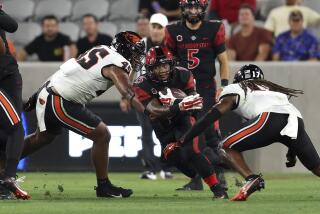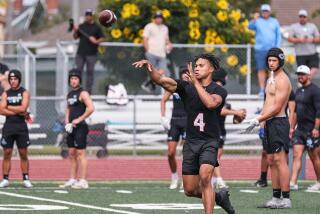Division II Up Next to Deal With Higher Academic Standards
NEW ORLEANS — The microphones have all been put away. The speakers have all gone home.
The NCAA convention is history and the controversial new academic guidelines for freshmen entering Division I schools are law.
Although those guidelines were softened a bit by an amendment that allows some flexibility in the rules until 1988, incoming freshmen must have a 2.0 grade-point average in 11 academic courses and a score of either 700 on the SAT college board exam or a 15 composite score on the ACT.
Division II must now decide whether to emulate its big brother on the issue.
Cal State Northridge President James W. Cleary thinks it’s a different ballgame at the lower level, however, where his school competes.
“I sure hope we don’t move in exactly the same direction,” he said, speaking over a late breakfast Wednesday before returning home. “Division I brought that situation down on themselves because they had graduates coming out of school who were simply inarticulate. They couldn’t meet the graduation requirements.
“Many feel it isn’t the same in Division II, and I agree. We simply don’t have the problem to that degree.
“Division III would not want to do anything because they regard Division III as academically pure, and I think that’s very true. They have no heavy recruitment. They have no grants-in-aid.
“Both our divisions have football players who are there because they like to play football. That’s why you haven’t seen any action by II or III on item 48, even though it came up two years ago, “ he said, referring to the rule on freshmen guidelines. “There is a strong belief we don’t have that problem.”
In his new role as chairman of the Division II Subcommittee of the NCAA Presidents Commission, Cleary will be actively involved in any debate on the subject.
“We will probably first address this issue in April,” he said, “and I would like to see us go at it in a constructive way.”
Cleary does not believe that constructive is a good way to describe what went on this week in New Orleans.
“I don’t know that it’s fair to set standards for student-athletes,” he said, “that we don’t demand of other students.”
Cleary, 58, has always been involved in athletics. In 1969, when he was leaving his position as vice chancellor for academic affairs at Wisconsin, one of his last acts was to secure the new athletic director. He hired Elroy Hirsch, one of the Rams’ great running backs in their early years in Los Angeles.
But never has Cleary been more deeply involved in athletics at CSUN than this year, his 17th as school president.
The duty has not always been pleasant. Last month, Tom Keele, football coach at Northridge for seven years, was terminated. It was subsequently revealed that Keele had held a secret tryout for kickers in violation of NCAA rules.
“To tell you the truth,” Cleary said, “I still don’t understand it. He was one of the most honest men I’ve known and I think that honesty came through when he admitted he acted alone. His honesty cut right through to the bone.
“But I don’t think any of that reflects on our program. In my 17 years here, I can’t recall any other infraction we were guilty of. What we did was self-reported.”
For that, he praised Bob Hiegert, men’s athletic director, and Judith Brame, women’s athletic director.
“They are excellent,” Cleary said. “You know, as I walked around this convention, people would tell me, ‘You are very lucky to have those two.’ ”
CSUN officials have scheduled a Friday news conference to name Keele’s successor.
“We have an obligation to point the program in a new direction,” Cleary said, “to freshen it up.”
And beyond that?
“There are rare instances,” Cleary conceded, “where an alumnus will ask if we are ever planning to move up to Division I.”
With a student body of about 28,000, Northridge has been criticized by some for failing to do just that.
“We have one of the best broad-based programs in the country, which is what the faculty wants and what we want,” Cleary said. “We have achieved more national championships over, I believe, the last dozen years than any other institution in the country. We are the only institution to have won three straight softball titles and, if we win a fourth this year, it will probably stand as a record for decades.
“There is more educational value in Division II than in a Division I program, where winning is the absolute objective. Those football programs are unstable. The turnover is so great. After two years, if they are not winning, that coach is out.”
But Cleary will not rule out anything.
“This doesn’t mean we will always be Division II and will not change,” he said. “I was saying facetiously in one of our meetings that the way things are going, Division I may someday become semiprofessional. If that happened, Division II would take the place of Division I. Division III becomes Division II. And another group becomes Division III.
“What we may be seeing is more and more movement from Division I into Division II in football because of the financial problems of maintaining a program of that size.”
In CSUN’s own conference, the Western Football Conference, membership has grown from four to seven schools in the last few years.
JAMES CLEARY ON . . . Higher entrance standards for Division I freshmen
‘I sure hope we don’t move in exactly the same direction. “Division I brought the situation on itself because they had graduates coming out of school who were simply inarticulate. Many feel it isn’t the same in Division II.’
Overall academic standards at Division I schools
‘There is more educational value in Division II than in a Division I program, where winning is the absolute objective. Those football programs are unstable. The turnover is so great.’
Possibility of new Division II applicants
‘What we may be seeing is more and more movement from Division I into Division II in football because of the financial problems of maintaining a program of that size.’
More to Read
Go beyond the scoreboard
Get the latest on L.A.'s teams in the daily Sports Report newsletter.
You may occasionally receive promotional content from the Los Angeles Times.






